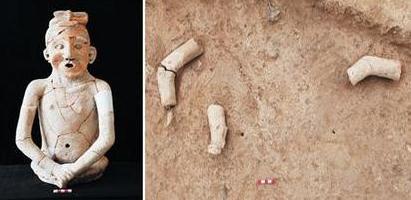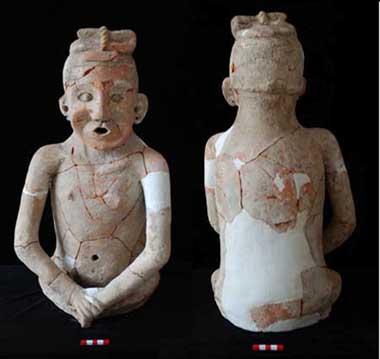Chinese Institute of Archaeology
Source - http://www.kaogu.cn/en/detail.asp?ProductID=3608
The Xinglonggou site is located in the Xinglonggou Village, Baoguotu Town, Aohan Banner, Inner Mongolia. It could be divided into three locales. Locale 1 was a settlement dating to the Middle Xinglongwa Culture, which is about 7600BP; Locale 2 was a settlement dating to the Late Hongshan Culture, which is about 5300BP; Locale 3 was a settlement dating to the Lower Xiajiadian Culture, which is about 4000-3500BP.

In order to complete the task of the Hongshan Culture settlement morphology research in the Exploring the Chinese Civilization Project III, the joint archaeological team combined with the Inner Mongolia archaeological working team I of the Institute of Archaeology, Chinese Academy of Social Sciences (IA CASS) and the Aohan Banner Museum investigated and mapped three sites dating to the Hongshan Culture in Aohan, which are Locale 2 of the Xinglonggou site, the Sijiazi Caomaoshan site, the Liujiatun site in Baoguotu Town, on May 22, 2012. On May 23 when the archaeologists went to map Locale 2, they collected red clay pottery shards and found they were the fragments of a figure’s face by piecing at the site. On May 28, the Aohan Banner Museum organized experts to go to the site again to do the collection and this time found the fragments of mouth. Then, the figure’s head, face and most of its body were recovered. Based on rich experience, Archaeologists considered this as a significant archaeological discovery and decided to do a salvage excavation.

After archaeologists sieved the soil within 100 square meters areas around the spot where the pottery figure was unearthed, some small fragments belonging to the pottery figure were found. After the cultivated soil was removed, archaeologists found a near square grey soil. According to the previous experience, this grey soil might have been a house ruin. During the following salvage excavation of the house ruin, the decoration fragments belonging to the figure’s forehead were accidently discovered on July 1. On July 3, archaeologists finally found a fragment belonging to one of the arms. On July 4, when the whole house ruin was cleared, another two fragments belonging to the arms were also discovered. After the careful restoration by the archaeologists, this pottery figure could be recovered. It is 55cm tall with a 65cm maximum breast circumference.

This is the biggest pottery figure among the discovered pottery figures so far which could be entirely recovered. Among the archaeological materials dating to the Hongshan Culture, there were some figures made of different materials, such as the small pottery figure from the Dongshanzui site in Kezuo County, Liaoning, which is only tens of centimeters tall and has no head discovered. In addition, many fragments belonging to the different body parts were discovered in the Goddess Temple at the Niuheliang site, Chaoyang, Liaoning, including the famous goddess head, arms, shoulders, breasts, ears and so on. Although some of these figures were as big as a real person or three times bigger than a real person, none of them included the whole body and over 50cm in height. Moreover, the figure’s fragments discovered in the Goddess Temple at the Niuheliang site were made of mud, while the figure discovered in the Locale 2 at the Xinglonggou site was red clay pottery, which was burned in high temperature and was hard. The figure’s head and face were almost complete and had complete crown. It had a bun and its eyes were widely open with a tall bridge of nose. Especially his risen lips and two sunken cheeks formed a shouting position. In addition, his arms bent, right hand holding left hand and legs crossing, showing this pottery figure is the one with most realistic features during the Hongshan Culture so far. It is very rare among the archaeological materials across the country. What it represents is the figure of our ancestors 5000 years ago. In view of this, this pottery figure is not a simple art piece, but has important religious and ritual significance. It supplied direct and important archaeological evidence for studying the society and primitive religion system during the Late Hongshan Culture, especially the position of the Hongshan Culture in the process of 5000 Chinese Civilization. Now, it has attracted the attention all over the world. (Translator: Zhai Shaodong)